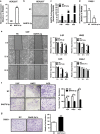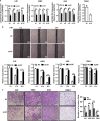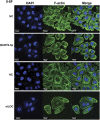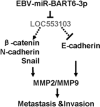Epstein-Barr virus-encoded miR-BART6-3p inhibits cancer cell metastasis and invasion by targeting long non-coding RNA LOC553103
- PMID: 27584792
- PMCID: PMC5059857
- DOI: 10.1038/cddis.2016.253
Epstein-Barr virus-encoded miR-BART6-3p inhibits cancer cell metastasis and invasion by targeting long non-coding RNA LOC553103
Abstract
Epstein-Barr virus (EBV) infection is causatively related to a variety of human cancers, including nasopharyngeal carcinoma (NPC) and gastric cancer (GC). EBV encodes 44 mature miRNAs, a number of which have been proven to promote carcinogenesis by targeting host genes or self-viral genes. However, in this study, we found that an EBV-encoded microRNA, termed EBV-miR-BART6-3p, inhibited EBV-associated cancer cell migration and invasion including NPC and GC by reversing the epithelial-mesenchymal transition (EMT) process. Using microarray analysis, we identified and validated that a novel long non-coding RNA (lncRNA) LOC553103 was downregulated by EBV-miR-BART6-3p, and LOC553103 knockdown by specific siRNAs phenocopied the effect of EBV-miR-BART6-3p, while LOC553103 overexpression promoted cancer cell migration and invasion to facilitate EMT. In conclusion, we determined that EBV-miR-BART6-3p, a microRNA encoded by oncogenic EBV, inhibited EBV-associated cancer cell migration and invasion by targeting and downregulating a novel lncRNA LOC553103. Thus, our study presents an unreported mechanism underlying EBV infection in EBV-associated cancer carcinogenesis, and provides a potential novel diagnosis and treatment biomarker for NPC and other EBV-related cancers.
Figures








Similar articles
-
Epstein-Barr virus-encoded miR-BART6-3p inhibits cancer cell proliferation through the LOC553103-STMN1 axis.FASEB J. 2020 Jun;34(6):8012-8027. doi: 10.1096/fj.202000039RR. Epub 2020 Apr 18. FASEB J. 2020. PMID: 32306460
-
EBV-miR-BART10-3p facilitates epithelial-mesenchymal transition and promotes metastasis of nasopharyngeal carcinoma by targeting BTRC.Oncotarget. 2015 Dec 8;6(39):41766-82. doi: 10.18632/oncotarget.6155. Oncotarget. 2015. PMID: 26497204 Free PMC article.
-
EBV-miR-BART8-3p induces epithelial-mesenchymal transition and promotes metastasis of nasopharyngeal carcinoma cells through activating NF-κB and Erk1/2 pathways.J Exp Clin Cancer Res. 2018 Nov 26;37(1):283. doi: 10.1186/s13046-018-0953-6. J Exp Clin Cancer Res. 2018. PMID: 30477559 Free PMC article.
-
Viral Carcinogenesis Beyond Malignant Transformation: EBV in the Progression of Human Cancers.Trends Microbiol. 2016 Aug;24(8):649-664. doi: 10.1016/j.tim.2016.03.008. Epub 2016 Apr 7. Trends Microbiol. 2016. PMID: 27068530 Free PMC article. Review.
-
The oncogenic role of Epstein-Barr virus-encoded microRNAs in Epstein-Barr virus-associated gastric carcinoma.J Cell Mol Med. 2018 Jan;22(1):38-45. doi: 10.1111/jcmm.13354. Epub 2017 Oct 9. J Cell Mol Med. 2018. PMID: 28990284 Free PMC article. Review.
Cited by
-
AFAP1-AS1: a rising star among oncogenic long non-coding RNAs.Sci China Life Sci. 2021 Oct;64(10):1602-1611. doi: 10.1007/s11427-020-1874-6. Epub 2021 May 13. Sci China Life Sci. 2021. PMID: 33999309 Review.
-
Role of the tumor microenvironment in PD-L1/PD-1-mediated tumor immune escape.Mol Cancer. 2019 Jan 15;18(1):10. doi: 10.1186/s12943-018-0928-4. Mol Cancer. 2019. PMID: 30646912 Free PMC article. Review.
-
Construction of a lncRNA-mRNA Co-Expression Network for Nasopharyngeal Carcinoma.Front Oncol. 2022 Jul 7;12:809760. doi: 10.3389/fonc.2022.809760. eCollection 2022. Front Oncol. 2022. PMID: 35875165 Free PMC article.
-
A network-based approach to identify DNA methylation and its involved molecular pathways in testicular germ cell tumors.J Cancer. 2019 Jan 29;10(4):893-902. doi: 10.7150/jca.27491. eCollection 2019. J Cancer. 2019. PMID: 30854095 Free PMC article.
-
Long non-coding RNAs (LncRNAs), viral oncogenomics, and aberrant splicing events: therapeutics implications.Am J Cancer Res. 2021 Mar 1;11(3):866-883. eCollection 2021. Am J Cancer Res. 2021. PMID: 33791160 Free PMC article. Review.
References
-
- Young LS, Rickinson AB. Epstein-Barr virus: 40 years on. Nat Rev Cancer 2004; 4: 757–768. - PubMed
-
- Young LS, Murray PG. Epstein-Barr virus and oncogenesis: from latent genes to tumours. Oncogene 2003; 22: 5108–5121. - PubMed
-
- He JR, Tang LY, Yu DD, Su FX, Song EW, Lin Y et al. Epstein-Barr virus and breast cancer: serological study in a high-incidence area of nasopharyngeal carcinoma. Cancer Lett 2011; 309: 128–136. - PubMed
MeSH terms
Substances
LinkOut - more resources
Full Text Sources
Other Literature Sources
Molecular Biology Databases
Miscellaneous

